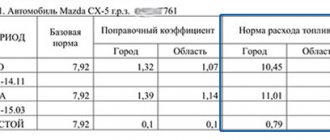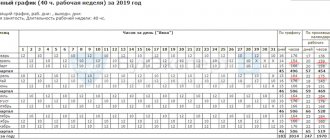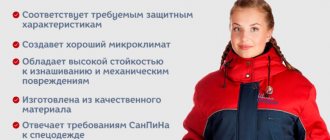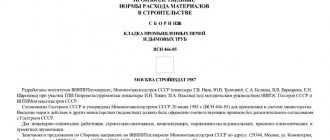Regulatory regulation
The document that sets fuel consumption standards is Order of the Ministry of Transport No. AM-23-r dated March 14, 2008. Organizations approve local standards for the write-off of fuels and lubricants and fuel consumption standards according to Order of the Ministry of Transport 23-r: it was not changed in 2022, the latest edition was released in September 2022. The changes were made by Order of the Ministry of Transport of the Russian Federation No. IA-159-r dated September 20, 2018.
The Ministry of Transport recommends calculating the volume of gasoline consumed as follows:
Where:
- QH - fuel consumption,
- HS is the basic fuel consumption rate per 100 km according to the Order of the Ministry of Transport for 2022 (set in l/100 km);
- S—car mileage;
- D is the correction factor.
The order establishes basic indicators for most car models. The current table of fuel consumption by car brands for 2022 is differentiated by type of vehicle (passenger cars, trucks, etc.) and contains thousands of items. Its beginning looks like this:
The correction factor is calculated based on surcharges to the base tariff established in connection with operating conditions.
Winter increase in fuel consumption standards - 2022: collection of questions and answers
Currently, fuel consumption standards for motor vehicles are set by the head of the organization independently or by contacting an accredited testing laboratory. Let's consider whether, when the manager independently sets standards, the so-called winter increase is applied and in what order.
1. Can an organization increase the fuel consumption rate when operating a vehicle at subzero temperatures? How to do this?
The legislation does not regulate how a manager determines the standards that he independently establishes <*>. In particular, it may provide that under different operating conditions of the vehicle, different fuel consumption rates apply. This can be done by setting:
— separate fuel consumption standards in absolute terms (liters or cubic meters per 100 km) for each combination of operating conditions;
— one standard of fuel consumption and correction factors (percents) for the corresponding operating conditions.
The list of vehicle operating conditions under which different fuel consumption standards apply, as well as the conditions for applying such standards, is also determined by the manager. In this case, you can focus on all or individual rules defined by Instruction No. 141, securing their use in the organization, or modify these rules. The obligation to follow Instruction No. 141 when independently establishing standards by the manager is not established either in Part 1, Clause 6 of Decree No. 503, or in Resolution No. 470.
In particular, the manager can set an increase in fuel consumption rates when operating a vehicle in winter conditions (winter increase in fuel consumption rates). The size of the increase or the rate of fuel consumption under appropriate operating conditions, as well as the procedure for application, is fixed by the manager in an administrative document, usually an order.
2. Is it possible to set a winter increase in fuel consumption standards if the manager has set the factory standard as the fuel consumption rate?
Since the legislation does not regulate how a manager determines the standards he independently sets, a winter increase in fuel consumption standards can be prescribed, including for situations where the manufacturer’s standard is used. The rule of Instruction No. 141 that the winter increase in fuel consumption norms applies only to the linear norms and fuel consumption norms established by the Ministry of Transport for transport work does not limit the manager in determining the norms <*>.
3. Can an organization set an increase in fuel consumption rates for the period of calendar winter (December-February) regardless of the air temperature on specific days of this season?
When increasing the fuel consumption rate in the case of operating a vehicle in winter conditions, it is necessary, first of all, to establish what will be understood in the organization by such operating conditions. The manager has the right to use the term presented in Instruction No. 141. In accordance with it, winter operating conditions of the car are the operation of the car in conditions of negative ambient temperature below 0 °C <*>.
But the content of this term can be adjusted. For example, determine that using a vehicle at an ambient temperature of 0 °C also applies to operating it in winter conditions. There may be other clarifications. However, to state that the fuel consumption rate increases for the period of calendar winter (December-February) regardless of the air temperature (other weather conditions) on specific days of this season will, in the author’s opinion, be incorrect. The calendar date itself does not determine the conditions in which the car is used - and, therefore, does not affect the amount of fuel consumption.
From what date do winter standards apply?
When the temperature drops below +5 °C, a winter supplement is applied, the duration of which depends on the region. There is no single standard for the date on which the transition to winter fuel consumption standards in 2022 by region will take place this winter. The transition is carried out depending on the climate zone. Both winter and summer fuel consumption standards depend on the climate of the place of operation - from which month they are introduced. In the central part of Russia, the winter premium is up to 10% and is introduced for five months: from November 1 to March 31. In the northern regions, the premium reaches 20% and applies up to 7 months a year.
The table shows winter fuel consumption rates by region in 2021:
| Subject of the Russian Federation or part thereof | Number of months and period from which to which winter period for cars in the region | Maximum amount of winter allowances, no more, % |
| Moscow | 5 01.11–31.03 | 10 |
| Belgorod region | 4 15.11–15.03 | 7 |
| Bryansk region | 5 01.11–31.03 | 10 |
| Vladimir region | 5 01.11–31.03 | 10 |
| Voronezh region | 5 01.11–31.03 | 10 |
| Ivanovo region | 5 01.11–31.03 | 10 |
| Kaluga region | 5 01.11–31.03 | 10 |
| Kostroma region | 5 01.11–31.03 | 10 |
| Kursk region | 5 01.11–31.03 | 10 |
| Lipetsk region | 5 01.11–31.03 | 10 |
A complete list of winter fuel consumption standards and the timing of their application in 2021 by climatic zone is presented in Appendix 2 to the methodological recommendations for establishing fuel consumption standards.
To switch to winter coefficients, it is recommended to issue an order.
Legislative framework of the Russian Federation
canceled/voided Edition dated 29.04.2003
detailed information
| Name of document | “NORMAL CONSUMPTION OF FUELS AND LUBRICANTS IN AUTOMOBILE TRANSPORT. R 3112194-0366-03" (approved by the Ministry of Transport of the Russian Federation on April 29, 2003) |
| Document type | classification, norms |
| Receiving authority | Ministry of Transport of the Russian Federation |
| Document Number | R 3112194-0366-03 |
| Acceptance date | 01.01.1970 |
| Revision date | 29.04.2003 |
| Date of registration with the Ministry of Justice | 01.01.1970 |
| Status | cancelled/lost force |
| Publication |
|
| Navigator | Notes |
“NORMAL CONSUMPTION OF FUELS AND LUBRICANTS IN AUTOMOBILE TRANSPORT. R 3112194-0366-03" (approved by the Ministry of Transport of the Russian Federation on April 29, 2003)
VALUES OF WINTER SUPPLEMENTS TO FUEL CONSUMPTION STANDARDS IN RUSSIA REGIONS BY CLIMATIC REGION <1>
| N p/p | Regions of Russia (by Federal Districts) | Number of months and validity period of allowances during the winter period of operation | Maximum amount of allowances during the winter period of operation, %, no more |
| 1 | 2 | 3 | 4 |
| I. Central | |||
| 1 | Moscow | 5.0 01.XI…31.III | 10 |
| 2 | Belgorod region | 4.0 15.XI…15.III | 7 |
| 3 | Bryansk region | 5.0 01.XI…31.III | 10 |
| 4 | Vladimir region | 5.0 01.XI…31.III | 10 |
| 5 | Voronezh region | 5.0 01.XI…31.III | 10 |
| 6 | Ivanovo region | 5.0 01.XI…31.III | 10 |
| 7 | Kaluga region | 5.0 01.XI…31.III | 10 |
| 8 | Kostroma region | 5.0 01.XI…31.III | 10 |
| 9 | Kursk region | 5.0 01.XI…31.III | 10 |
| 10 | Lipetsk region | 5.0 01.XI…31.III | 10 |
| 11 | Moscow region | 5.0 01.XI…31.III | 10 |
| 12 | Oryol region | 5.0 01.XI…31.III | 10 |
| 13 | Ryazan region | 5.0 01.XI…31.III | 10 |
| 14 | Smolensk region | 5.0 01.XI…31.III | 10 |
| 15 | Tambov region | 5.0 01.XI…31.III | 10 |
| 16 | Tver region | 5.0 01.XI…31.III | 10 |
| 17 | Tula region | 5.0 01.XI…31.III | 10 |
| 18 | Yaroslavl region | 5.0 01.XI…31.III | 10 |
| II. Northwestern | |||
| 19 | Saint Petersburg | 5.0 01.XI…31.III | 10 |
| 20 | Republic of Karelia | 5.5 1.ХI…15.IV | 12 |
| 21 | Komi Republic | 6.0 1.XI…30.IV | 15 |
| 22 | Arkhangelsk region (without Nenets Autonomous Okrug) | 6.0 1.XI…30.IV | 15 |
| 23 | Vologda region | 5.0 01.XI…31.III | 10 |
| 24 | Kaliningrad region | 4.0 15.XI…15.III | 7 |
| 25 | Leningrad region. | 5.0 01.ХI…31.III | 10 |
| 26 | Murmansk region | 6.0 1.XI…30.IV | 15 |
| 27 | Novgorod region | 5.0 01.ХI…31.III | 10 |
| 28 | Pskov region | 5.0 01.ХI…31.III | 10 |
| 29 | Nenets Aut. district | 6.0 15.X…15.IV | 18 |
| III. North Caucasian | |||
| 30 | Republic of Adygea | 3.0 1.XII…1.III | 5 |
| 31 | The Republic of Dagestan | 3.0 1.XII…1.III | 5 |
| 32 | The Republic of Ingushetia | 3.0 1.XII…1.III | 5 |
| 33 | Chechen Republic | 3.0 1.XII…1.III | 5 |
| 34 | Kabardino-Balkarian Republic | 3.0 1.XII…1.III | 5 |
| 35 | Republic of Kalmykia | 5.0 15.X…15.III | 10 |
| 36 | Karachay-Cherkess Republic | 3.0 1.XII…1.III | 5 |
| 37 | Republic of North Ossetia-Alania | 3.0 1.XII…1.III | 5 |
| 38 | Krasnodar region | 3.0 1.XII…1.III | 5 |
| 39 | Stavropol region | 3.5 1.XII…15.III | 5 |
| 40 | Astrakhan region | 5.0 15.X…15.III | 10 |
| 41 | Volgograd region | 5.0 15.X…15.III | 10 |
| 42 | Rostov region | 4.0 15.XI…15.III | 7 |
| IV. Privolzhsky | |||
| 43 | Republic of Bashkortostan | 5.5 1.XI…15.IV | 12 |
| 44 | Mari El Republic | 5.0 01.XI…31.III | 10 |
| 45 | The Republic of Mordovia | 5.0 01.XI…31.III | 10 |
| 46 | Republic of Tatarstan | 5.0 01.XI…31.III | 10 |
| 47 | Udmurt republic | 5.0 01.XI…31.III | 10 |
| 48 | Chuvash Republic | 5.0 01.XI…31.III | 10 |
| 49 | Kirov region | 5.5 15.X…31.III | 12 |
| 50 | Nizhny Novgorod region. | 5.0 01.XI…31.III | 10 |
| 51 | Orenburg region | 6.0 15.X…15.IV | 15 |
| 52 | Penza region | 5.0 01.XI…31.III | 10 |
| 53 | Perm region (without Komi-Permyak Autonomous Okrug) | 5.5 1.XI…15.IV | 10 |
| 54 | Samara region | 5.0 01.XI…31.III | 10 |
| 55 | Saratov region | 5.0 01.XI…31.III | 10 |
| 56 | Ulyanovsk region | 5.0 01.XI…31.III | 10 |
| 57 | Komi-Permyak Autonomous Okrug | 6.0 15.X…15.IV | 18 |
| V. Ural | |||
| 58 | Kurgan region | 5.5 1.XI…15.IV | 10 |
| 59 | Sverdlovsk region. | 5.5 1.XI…15.IV | 10 |
| 60 | Tyumen region (without Khanty-Mansiysk and Yamalo-Nenets Autonomous Okrug) | 5.5 1.XI…15.IV | 12 |
| 61 | Chelyabinsk region | 5.5 1.XI…15.IV | 10 |
| 62 | Khanty-Mansiysk Autonomous Okrug | 6.5 15.X…30.IV | 18 |
| 63 | Yamalo-Nenets Autonomous Okrug | 6.5 15.X…30.IV | 18 |
| VI. Siberian | |||
| 64 | Altai Republic | 5.5 1.XI…15.IV | 15 |
| 65 | The Republic of Buryatia | 6.0 1.IX…30.IV | 18 |
| 66 | Republic of Tuva | 6.0 1.IX…30.IV | 18 |
| 67 | The Republic of Khakassia | 6.0 1.IX…30.IV | 18 |
| 68 | Altai region | 5.5 1.XI…15.IV | 15 |
| 69 | Krasnoyarsk Territory (without Taimyr and Evenki Autonomous Okrug) | 5.5 1.XI…15.IV | 15 |
| 70 | Irkutsk region (without Ust-Orda Buryat Autonomous Okrug) | 6.0 1.IX…30.IV | 18 |
| 71 | Kemerovo region. | 6.0 1.IX…30.IV | 15 |
| 72 | Novosibirsk region | 5.5 1.XI…15.IV | 12 |
| 73 | Omsk region | 5.5 1.XI…15.IV | 12 |
| 74 | Tomsk region | 5.5 1.XI…15.IV | 12 |
| 75 | Chita region (without Aginsky Buryat Autonomous Okrug) | 6.0 1.IX…30.IV | 18 |
| 76 | Taimyr Autonomous Okrug | 7.0 15.X…15.V | 18 |
| 77 | Ust-Ordynsky Buryat Autonomous Okrug | 6.0 1.IX…30.IV | 18 |
| 78 | Evenki Autonomous Okrug | 7.0 15.X…15.V | 18 |
| 79 | Aginsky Buryat Autonomous Okrug | 6.0 1.IX…30.IV | 18 |
| VII. Far Eastern | |||
| 80 | Republic of Sakha-Yakutia (without Chukotka Autonomous Okrug) | 7.0 15.X…15.V | 20 |
| 81 | Primorsky Krai | 5.5 1.XI…15.IV | 12 |
| 82 | Khabarovsk region | 5.5 1.XI…15.IV | 12 |
| 83 | Amur region | 6.0 1.XI…30.IV | 15 |
| 84 | Kamchatka region (without Koryak Autonomous Okrug) | 6.0 1.XI…30.IV | 15 |
| 85 | Magadan region | 6.5 15.X…30.IV | 18 |
| 86 | Sakhalin region - south | 5.0 15.XI…15.IV | 12 |
| Sakhalin region — north (above 50 degrees north latitude) | 6.0 1.XI…30.IV | 15 | |
| 87 | Jewish Autonomous Region | 5.5 1.XI…15.IV | 12 |
| 88 | Koryak Autonomous Okrug | 6.0 1.XI…30.IV | 15 |
| 89 | Chukotka Autonomous Okrug | 6.5 15.X…30.IV | 20 |
| 90 | Islands of the Arctic Ocean and seas | 7.0 1.XI…31.V | 20 |
<1> The procedure for applying surcharges to fuel consumption standards in the winter season
The maximum values of winter surcharges to vehicle fuel consumption standards are differentiated by region of Russia based on the values of average monthly, maximum and minimum air temperatures, data on the average duration of the winter period, generalization of experience in operating road transport in the regions - in accordance with GOST 16350-80 “Climate of the USSR. Zoning and statistical parameters of climatic factors for technical purposes.”
It is recommended that the specified period for applying winter allowances to the norm and their amount be formalized by order of regional (local) authorities, and in the absence of relevant orders - by orders of enterprise managers.
Regional (local) authorities or enterprise managers can clarify the initial and final periods of application and values of winter surcharges, within the recommended limits for a given region, in case of significant deviations (decrease or increase) in temperatures from the average daily or monthly long-term average values - in agreement with regional (local) services of the Hydrometeorological Center of the Russian Federation.
This temperature limit is taken to be minus 5 degrees. C, below and above which it is possible to make appropriate clarifications on the application of winter allowances.
When operating vehicles away from their main bases (while on business trips in other climatic regions), the allowances established for the area of operation of the vehicle are applied.
For intercity transportation of goods and passengers (travel to other climatic zones), it is recommended to apply the surcharges established for the starting and final points of the route.
Appendix 3
(Informative)
Other types of allowances to basic standards
In addition to seasonal operating conditions, the order AM-23-r establishes the following reasons for increasing the basic tariffs for the consumption of fuel and lubricants:
- work in mountainous areas (from 5 to 20%);
- operation in populated areas with a large population (from 5 to 35%);
- driving at a reduced speed (for example, at a speed below 20 km/h - up to 35%);
- operation over 5 years and mileage over 100,000 km (5%), over 8 years and 150,000 km (10%);
- use of air conditioning (up to 10%).
In some cases, the basic standards are lowered. For example, when operating on flat terrain outside populated areas.
What does tax law say?
The basic fuel consumption rate established by the Ministry of Transport is not mandatory. The Tax Code does not contain requirements for the need to regulate the consumption of fuel and lubricants. The organization has the right to write off fuel costs for vehicles in the amount of actual costs. This rule applies both to OSNO when calculating income tax, and to the simplified tax system.
This position is currently adhered to by the Ministry of Finance (letter No. 03-03-06/1/2875 dated January 27, 2014). The regulatory authorities indicate that the costs of fuel and lubricants must be economically justified and documented, and no requirements for their standardization have been established in the Tax Code of the Russian Federation. But the taxpayer has the right to establish the amount of write-off, based on the methodological recommendations of the Ministry of Transport No. AM-23-r.
ConsultantPlus experts discussed how to calculate fuel consumption according to standards. Use these instructions for free.
For quite a long time, regulatory authorities held the opposite point of view. Back in 2010, in letter No. 03-03-06/2/57 dated 09/03/2010, the Ministry of Finance indicated the taxpayer’s obligation to apply fuel consumption standards established by the Ministry of Transport. But then, under the influence of judicial practice, the Ministry of Finance changed its point of view. And now, in order to apply other write-off standards, the taxpayer must document the legality of writing off fuel and lubricants in the amount in which they were actually consumed.
How to develop your own standards
Organizations are not required to follow the standards established by the Ministry of Transport in Order No. AM-23-r. In its internal regulatory documents, the company has the right to establish accounting for fuel and lubricants in costs in the volumes actually consumed. And use as supporting documents for the purchase of fuel and waybills indicating the operation of the car.
However, for the purpose of internal control over the consumption of fuel and lubricants, the organization has the right to develop and establish its own standards. For this they rely on:
- to the standards of the Ministry of Transport;
- on the manufacturer's recommendations;
- to their own control figures, approved by a special commission based on control measurements.
The same order states when switching to the summer fuel consumption rate, what other correction factors are applied depending on the operating conditions of the vehicle.
What it is
Accounting for road transport, climatic and other operational factors is carried out using correction factors for surcharges, regulated in the form of percentage increases or decreases in the initial value; the norms for their values are established by the decision of the legal entity or individual entrepreneur operating the vehicle. A simplified version involves finding the quotient of the amount of fuel spent and the kilometers traveled to establish a percentage, the figure is multiplied by 100.










